This post may contain affiliate links. Please read our disclosure policy.
Sweet pumpkin preserves 2-ways – candied pumpkin in syrup and pumpkin jam! All you need is a handful of ingredients to prepare either of these sweet pumpkin recipes – perfect for water bath canning to keep in your pantry for up to a year!
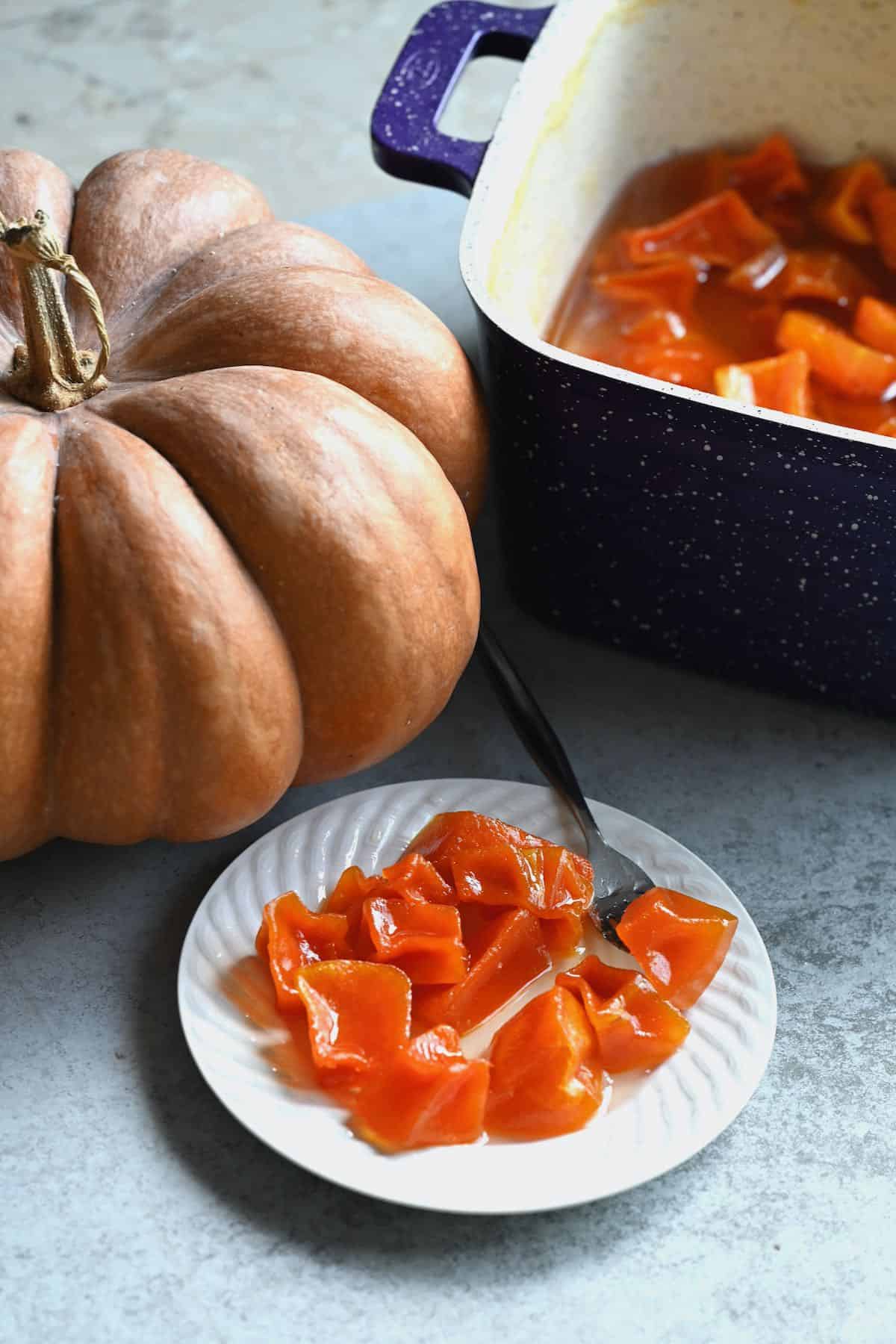
Want to save this recipe?
Table of Contents
- How to Preserve Pumpkin Two Ways: Candied and Jam
- The Ingredients
- Optional Add-ins and Variations
- How to Make Pumpkin Preserves (Candied Pumpkin + Pumpkin Jam)
- How to Store Pumpkin Preserves
- How to Serve?
- FAQs
- Recipe Notes and Top Tips
- Related Recipes and DIYs
- Pumpkin Preserves (Candied Pumpkin + Pumpkin Jam) Recipe
How to Preserve Pumpkin Two Ways: Candied and Jam
We’re in the thick of Fall/Autumn right now, and I’m busy taking advantage of pumpkin season with big batches of pumpkin soup, creamy no-bake vegan pumpkin pie, pumpkin hummus (sweet or savory!), and boatloads of pumpkin spice lattes. However, there’s another pumpkin treat you may not have heard of before that deserves a shout-out this fall. That’s candied pumpkin (plus a bonus pumpkin jam)!
Usually, when people refer to candied pumpkin, they mean Mexican pumpkin candy (calabaza en tacha/ dulce de calabaza), which is enjoyed in Mexico as a snack and for the Day of The Dead. However, there is another version of candied squash popular in Turkey and the Middle East. It’s the latter method I’ll be showing you today (doubled up with a simple pumpkin jam!).
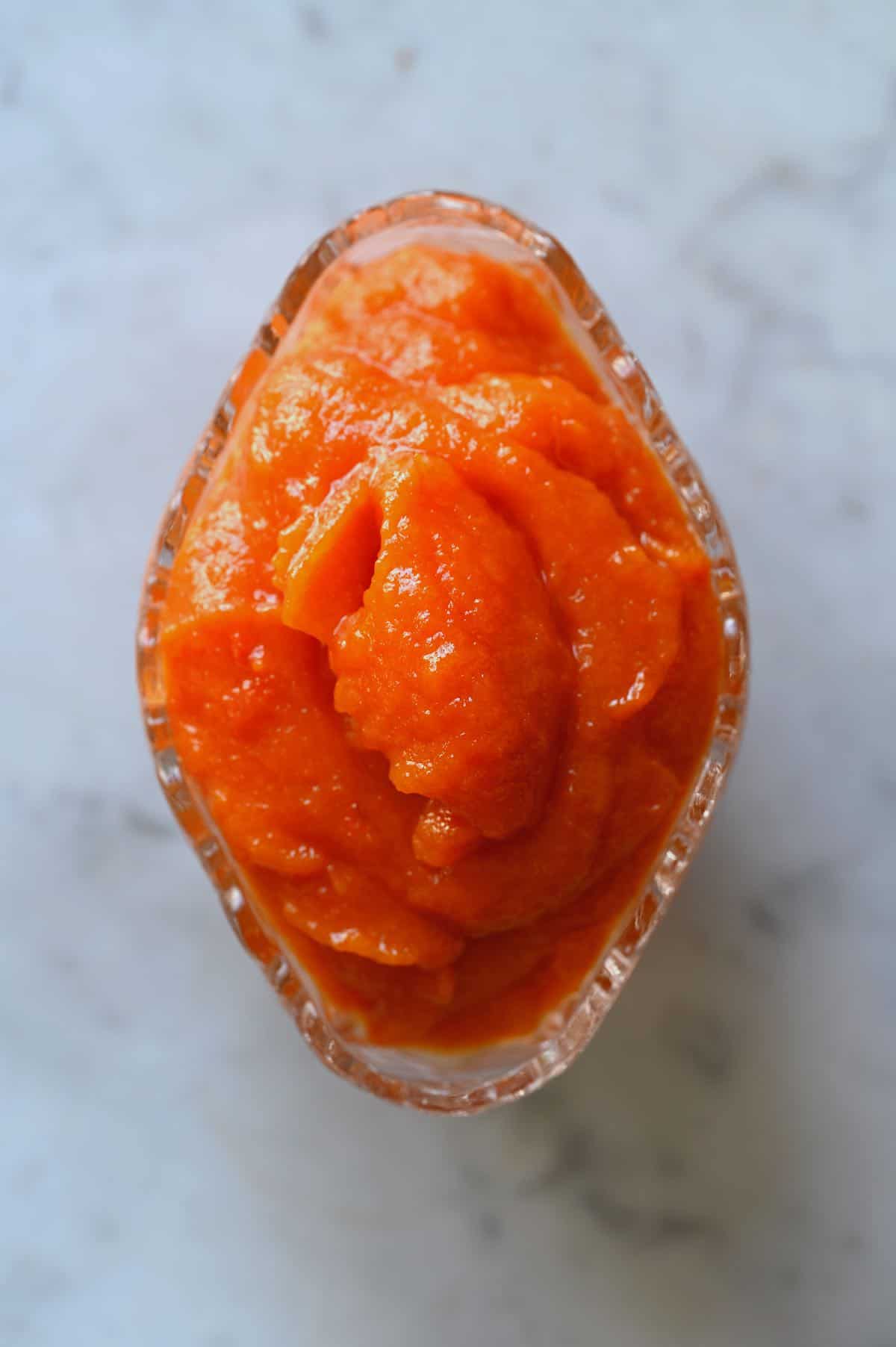
When making candied pumpkin in syrup, the aim is to have firm pieces of pumpkin that are tender in the middle. However, they should hold their shape well, with a crispy outer shell (thanks to pickling lime or pickle crisp). While the process takes a long time, the actual hands-on time is minimal, and the method is simple!
After slowly simmering the pumpkin on the stovetop for several hours, you can then either blend it into a jam, enjoy it immediately in chunks, or water bath can it for up to a year of storage in your pantry (likewise with the pumpkin jam). That way, you can enjoy these pumpkin preserves year-round! For those short on time, I’ve even included my super quick “cheat” pumpkin jam in 20 minutes(-ish!).
The Ingredients
- Pumpkin: make sure to use a culinary pumpkin for the best flavor (not carving pumpkin). I love using sugar pumpkins, but you can also use varieties that aren’t as sweet since there’s so much sugar in the recipe. You could also make this with squash (like butternut squash).
- Sugar: you’ll need an equal amount of granulated sugar (in weight) to the amount of pumpkin used. I haven’t tried this recipe with any sugar other than regular white granulated, though brown sugar should work too.
- Water: you need water for soaking the pumpkin and when cooking it.
- Lemon juice: to help balance the super-sweet flavor of the candied pumpkin/pumpkin jam. A combination of orange and lemon juice would add interesting flavor.
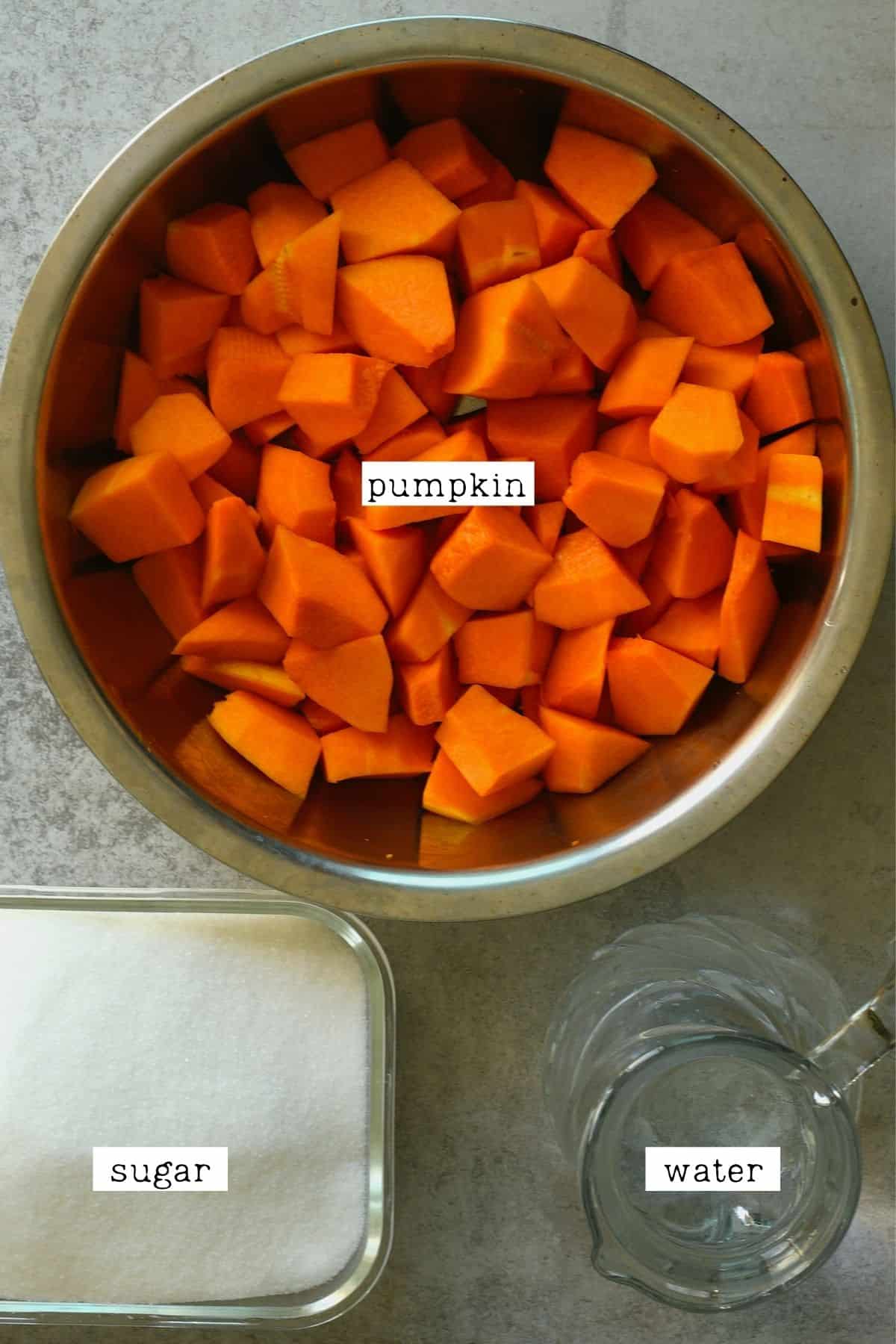
Depending on the final desired texture, you will also need:
- Pickling lime: Also called calcium hydroxide, slaked lime, or cal. Make sure to use food-grade lime. This will help the pumpkin cubes to retain their shape and become crunchy (not too soft). However, this ingredient is controversial (FAQs for more info).
- Pickle crisp: I haven’t tried this for pumpkin preserves, though it is a non-controversial alternative to the lime and should have similar results, though possibly not as crisp outside.
- Corn starch: this is an alternative to using the pickling lime but, while it will help the pumpkin retain its shape (not disintegrate into a paste), it won’t make it “crisp” outside.
Why do you need to use one of the above? If you simply boil the pumpkin in the syrup for hours, it will completely break down. Meaning you’ll end up with a disintegrated, mushy, pulpy mess -rather than individual pieces of pumpkin within a syrup. Any of the above ingredients will help us to avoid the “mush” stage.
If you want to make a soft pumpkin jam, you won’t need the above and can skip the “soaking” step.
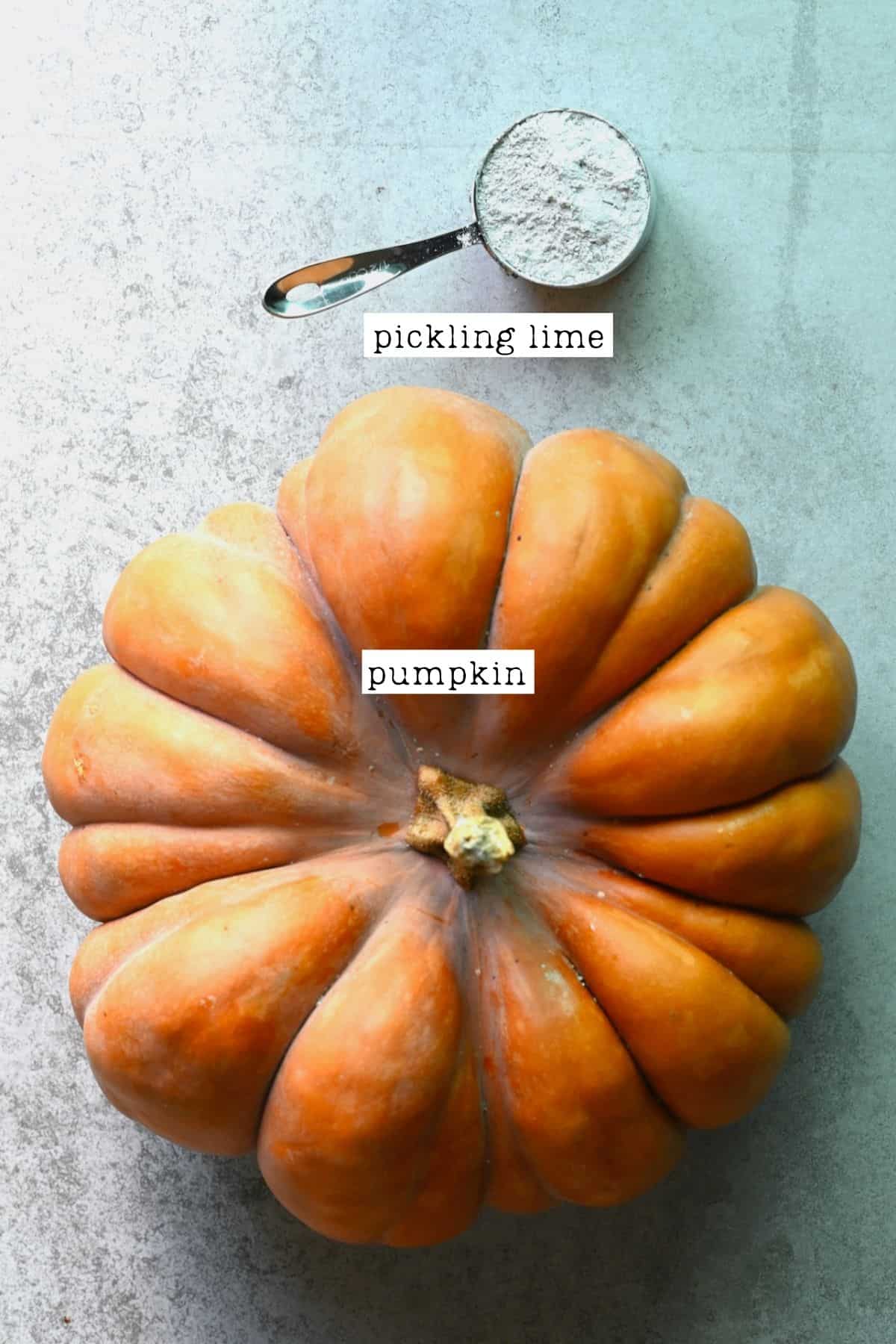
Optional Add-ins and Variations
- Mastic powder: this is optional but is an aromatic powder that can help to add extra flavor to the candied pumpkin/syrup mixture. The taste is hard to describe but is like woodsy, musky vanilla with hints of anise/mint.
- Pumpkin seeds/pistachios: you can add them directly to the jar with the candied pumpkin or just use them to garnish when serving.
- Orange zest: add 1/2-1 orange zest to the sugar syrup mixture to infuse it with extra flavor.
- Vanilla: I recommend using around ½ a vanilla bean, scraping out the seeds, and throwing the entire pod in while cooking (then remove the pod at the end). Alternatively, use some vanilla extract.
- Spices: there are several easy ways you can add more flavor to the pumpkin preserves, including adding cinnamon (sticks or powdered), nutmeg, whole cloves (just 2-3 as the taste is strong!), or even pumpkin pie spice.
- Ginger: just a little fresh ginger can help to infuse the pumpkin (and syrup) with more flavor. It works well for the jam too.
- Chili: adding a small amount of finely chopped chili can help balance the sweetness and add a pop of heat to the pumpkin preserves. Adjust the amount to taste but I recommend 1 small red chili to begin.
How to Make Pumpkin Preserves (Candied Pumpkin + Pumpkin Jam)
Step 1: Prepare the Pumpkin
First, wash and cut the pumpkin into small bite-sized pieces (around ¾-1-inch cubes). Next, peel or chop the skin away and remove all the pulp and stringy flesh.
Then, weigh the pumpkin so you know the exact weight (as you’ll need the same amount of sugar to pumpkin weight).
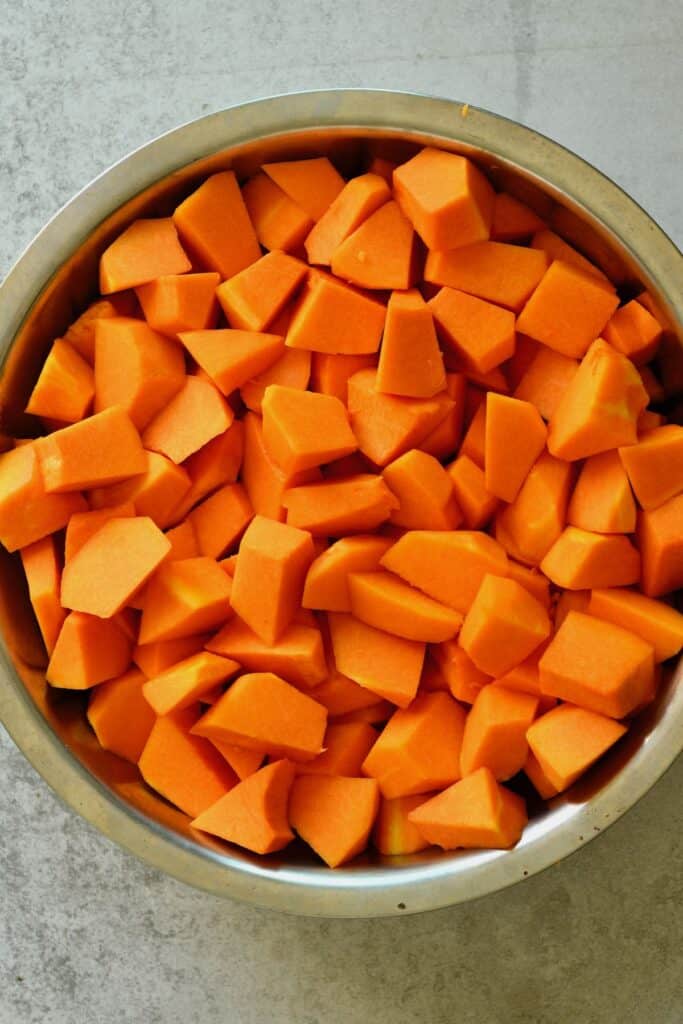
Step 2: Soak and Rinse the Pumpkin
If you plan to make pureed pumpkin jam, you can skip to Step 3.
Combine the water (you’ll need between 9-12 cups depending on the container you’re using) and pickling lime (or starch) in a container large enough to fit all the pumpkin pieces. Allow it to dissolve in the water for 10-15 minutes.
Add the pumpkin and allow it to soak for about six hours (though up to 12-24 works too to help the pumpkin retain its shape).
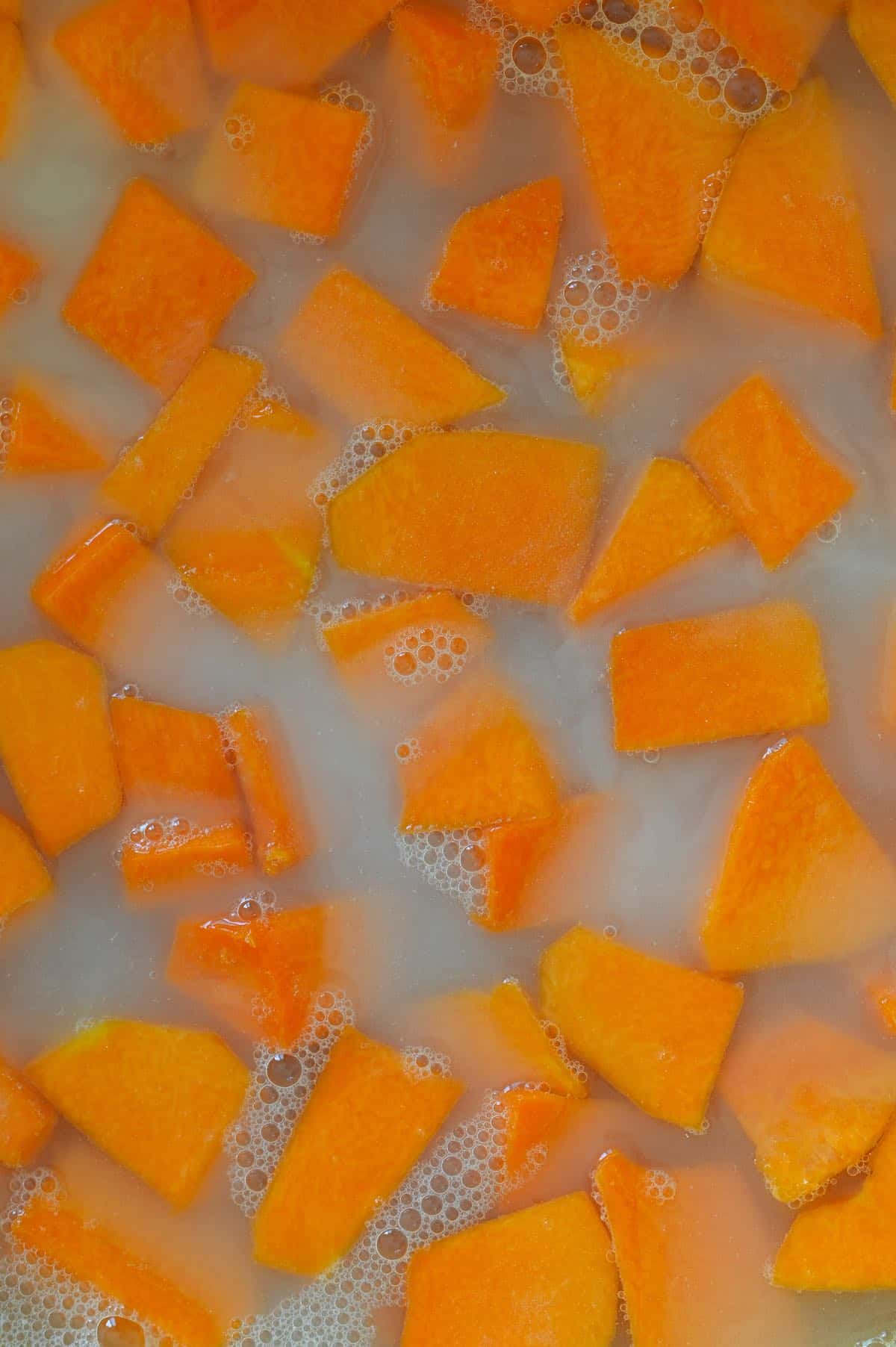
If you want to use pickle crisp, I recommend using 2 teaspoons per 1 gallon of water. Wait until it dissolves, add the pumpkin, and leave it to soak for 2 hours – no rinse necessary.
After soaking, thoroughly drain the liquid and then rinse the pumpkin THOROUGHLY (if using pickling lime; there’s no need when using pickle crisp or starch). I do this multiple times until I’m sure the pieces are completely free of any pickling lime residue. The best way is to first allow them to soak in clean water for an hour. Then continue to rinse and soak the pumpkin in clean water a further two times.
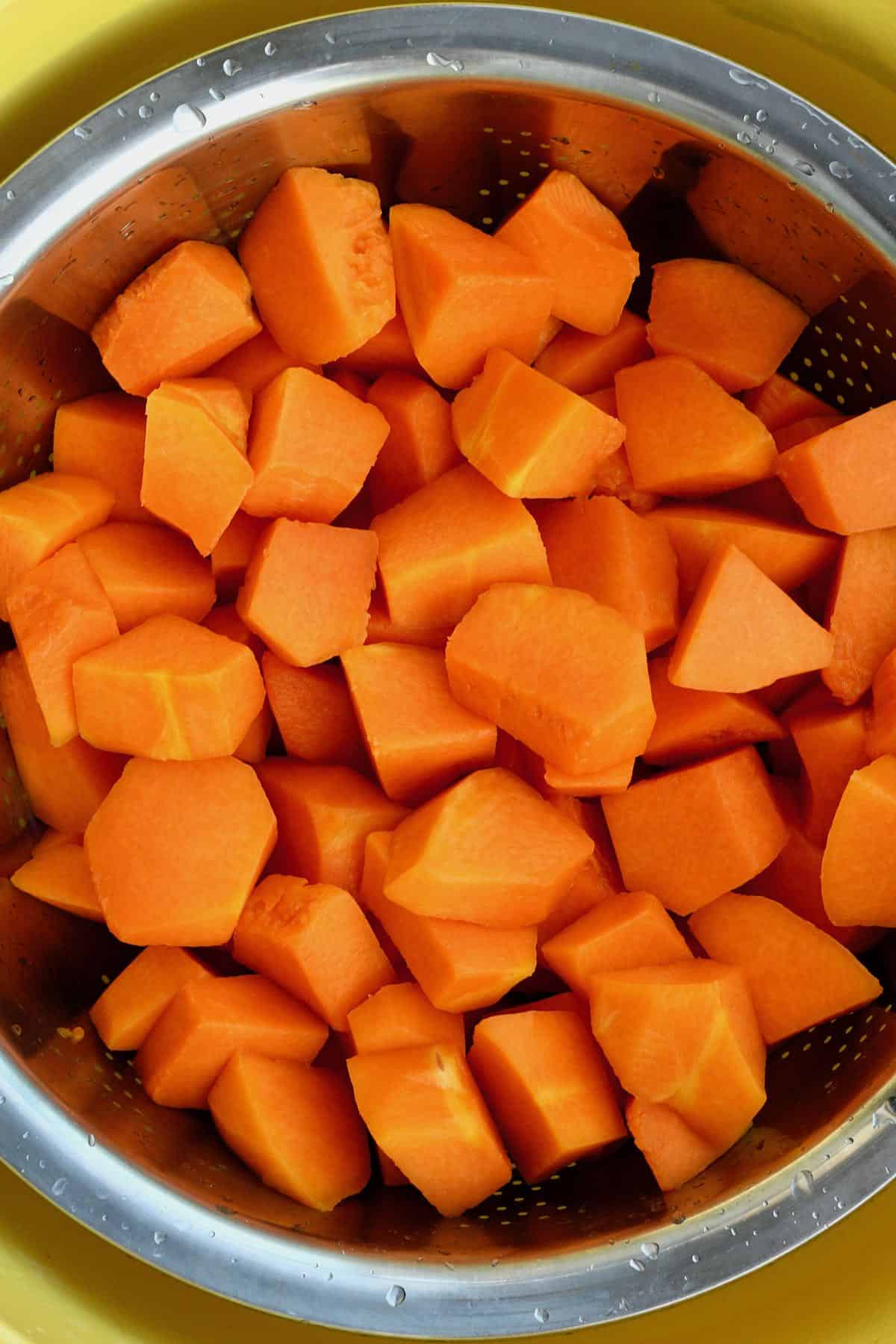
Step 3: Simmer the Pumpkin in Syrup
Add the pumpkin, sugar, and water in a large, thick-based pan and bring to a boil over medium – medium-high heat. As foam/scum forms at the top of the pan, simply scoop it out with a spoon.
Once it begins to boil, reduce the heat to a gentle simmer. Cook for between 3-4 hours as the mixture thickens and candies the pumpkin pieces. It’s ready when the syrupy sauce coats the back of a spoon.
Finally, add the lemon juice to the candied pumpkin mixture and remove the pan from the heat. Allow it to cool before transferring to a sterilized container/s.
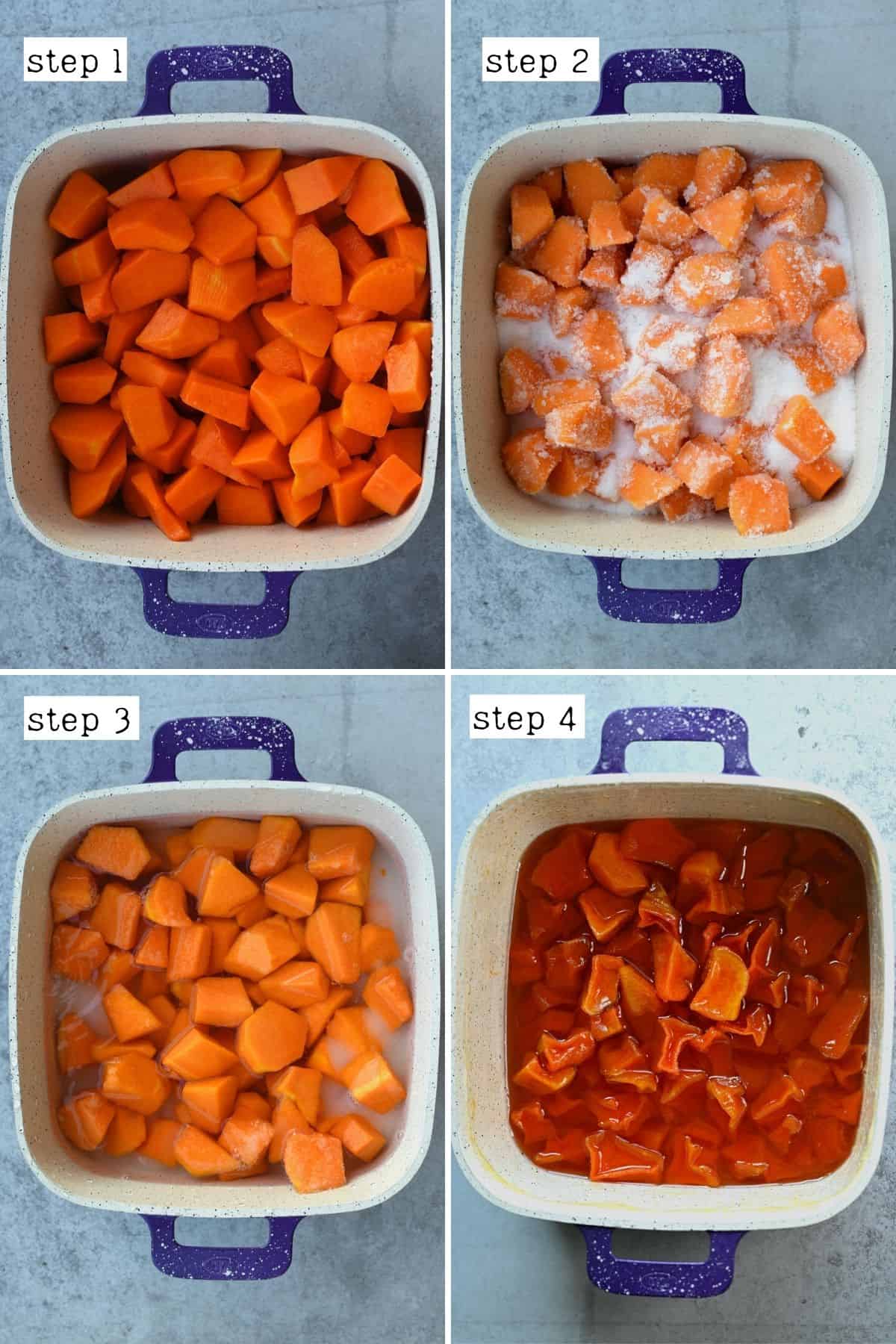
If you’re making pumpkin jam, you can get away with simmering for an hour. Then use an immersion blender or regular blender to form a smooth puree before transferring it to the container.
Quick “Cheat” Pumpkin Jam
If you want to make a super quick, simple pumpkin jam (similar to pumpkin butter), you can cut out several steps (and ingredients).
For a small batch, I recommend using 15oz (400g) of pumpkin puree (that way, you can use homemade or canned pumpkin), an equal amount of sugar (around 2 cups/400g), 1-2 tablespoons of lemon juice (or orange), and 1-2 tsp pumpkin pie spice (or just a pinch of cinnamon and nutmeg). Feel free to adjust the citrus and spices to personal taste!
First, add the pumpkin, citrus, and spices to a medium or large saucepan. Cook over medium-high, stirring often, for a couple of minutes. Then, add the sugar, and mix it in well. Continue to cook until it begins to boil, then slightly reduce the heat and cook, stirring constantly, until the sugar is fully dissolved and the mixture thickens (10-15 minutes) into a moldable consistency. Finally, taste the pumpkin jam and adjust the spices or citrus to taste. Then remove from the heat, allow to cool slightly, and transfer to a sterile glass jar.
If you use fresh pumpkin puree, this is usually “wetter” than canned, so it will take longer to thicken and reduce. Note that this mixture also “spits” quite a lot while cooking, so wear an apron/ oven mitt if preferred.
You can store this pumpkin pie jam in the fridge for up to three months. You may also be able to water-bath-can it, though refer to professional guidelines for advice.
How to Store Pumpkin Preserves
Store: you can store the candied pumpkin and pumpkin jam in sterilized glass jars in the fridge for up to three months.
Note that it’s possible to water bath can (full method instructions in link) this recipe – processing it for 10 minutes. If you do so, the pumpkin preserves will last for 12 months (at least!).
Freeze: I haven’t tried to freeze either of these pumpkin preserves, though I imagine the pumpkin jam would freeze well for several months. It may impact the texture of the candied pumpkin, though.
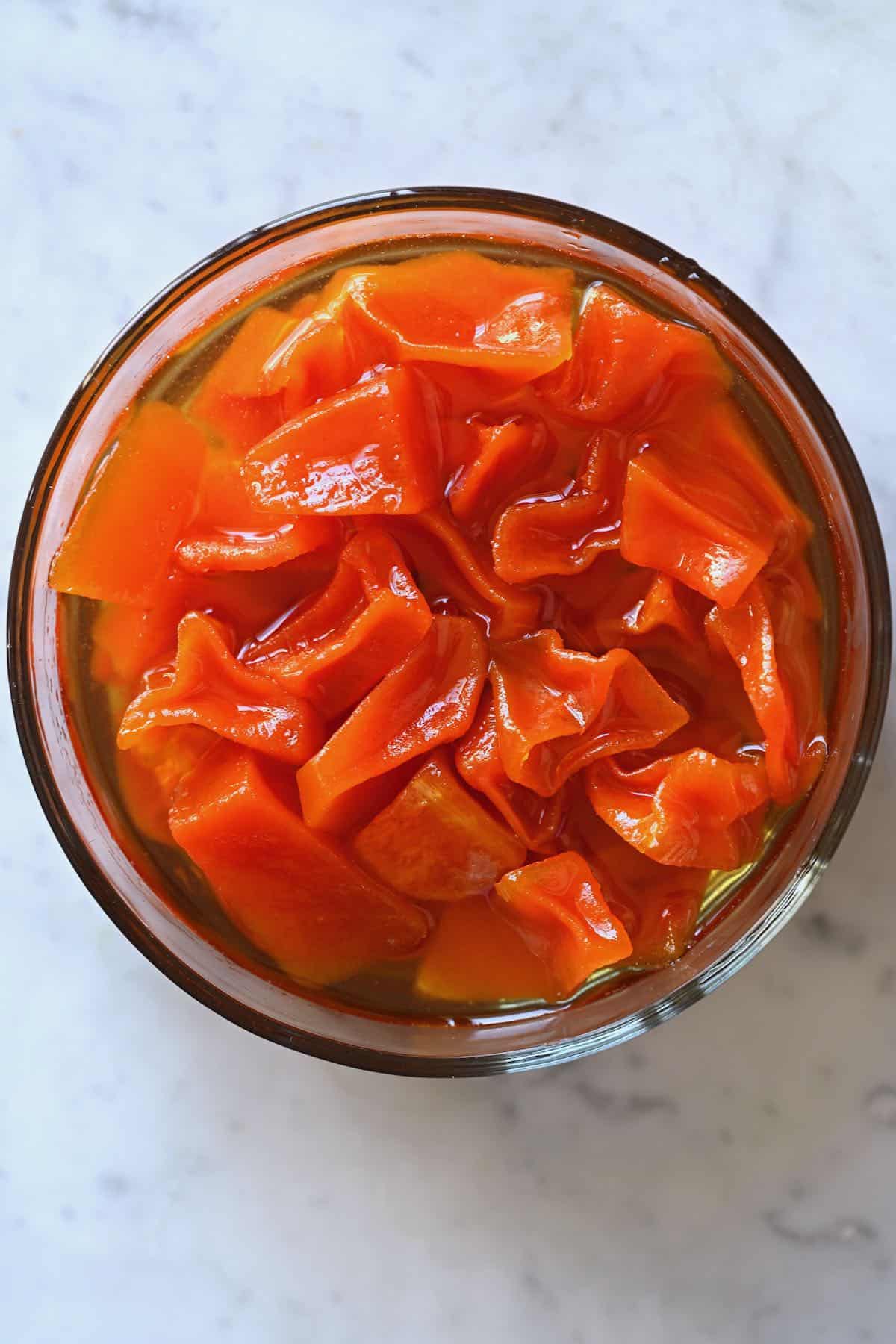
How to Serve?
Both the pumpkin jam and candied pumpkin make for delicious toppings for toast and bagels. The pumpkin jam also works particularly well for adding to other pastries, pies, cakes, and breads. Or even water it down slightly and use it as a meat glaze.
However, the candied pumpkin can also be enjoyed:
- As a dessert: either alone or with some of its syrup; optionally topped with some crushed nuts/seeds and a little whipped cream (or coconut whipped cream) or even ice cream.
- With milk: like the Mexican candied pumpkin, this version can be enjoyed in a bowl with milk (dairy or dairy-free) and a little drizzle of the syrup. Again, this can be enjoyed chilled or warm.
- With coffee: serve a cube or two as a sweet treat with a cup of strong Turkish coffee.
- As part of a cheeseboard: because of how sweet the candied pumpkin and pumpkin jam are, they pair well with the salty, savory flavor of many cheese varieties on a cheese board.
- Sometimes I’ll just take a piece straight from the jar when I have sugar cravings, as a quick snack.
The simple syrup is also great for drizzling over ice cream, pancakes, waffles, etc.
FAQs
While the sugar amount seems high, the sugar acts both as a sweetener AND preservative in this recipe. In jam, it also impacts the consistency. The traditional ratio is 1:1 fruit to sugar to provide the best shelf life.
I would only recommend experimenting with reducing the sugar amount if you plan to make the pureed pumpkin jam (not the candied pumpkin, as I imagine the consistency of the syrup would be off). However, even then, remember that the less sugar you add, the more the shelf-life is impacted, so any less than a 1:1 ratio, and I can’t guarantee the 1-year shelf-stable water bath canned pumpkin jam.
For example, if only a few tablespoons of sugar are added, I wouldn’t recommend storing the jam for longer than 5-7 days in the refrigerator.
Food grade pickling lime (also called calcium hydroxide, slack lime, slaked lime, lime, calcium hydrate, etc.) is a type of white chemical powder that was a once-popular addition in pickle recipes to help enhance the “crispness” of the finished pickled.
The way it worked was to add calcium into the natural pectin in the food being pickled. In the case of candied pumpkin, it helps the pumpkin pieces to maintain their shape and texture when simmered for hours during the candying process.
However, this ingredient is also relatively controversial and not often recommended in modern preserved recipes. This is because it can impact the pH level in the food (as it’s alkaline) and could potentially lead to botulism in home-canned foods unless the lime is thoroughly rinsed from the food (usually several times). You can use pH strips to check the acidity of the pumpkin preserves before canning.
You could buy it online (make sure to get food-grade!) OR it’s often found in Asian and Latino supermarkets (sometimes simply labeled “Cal”).
Part of the “individuality” of this method of candied pumpkin is the super long simmer. If you reduce it (for example, between 30-40 minutes, until the pumpkin is fork-tender), then you’ll have a version that’s closer to Mexican calabaza en tacha (which uses “piloncillo” a brown cane sugar similar to Gur in place of regular granulated sugar, with orange juice/zest, and cinnamon sticks).
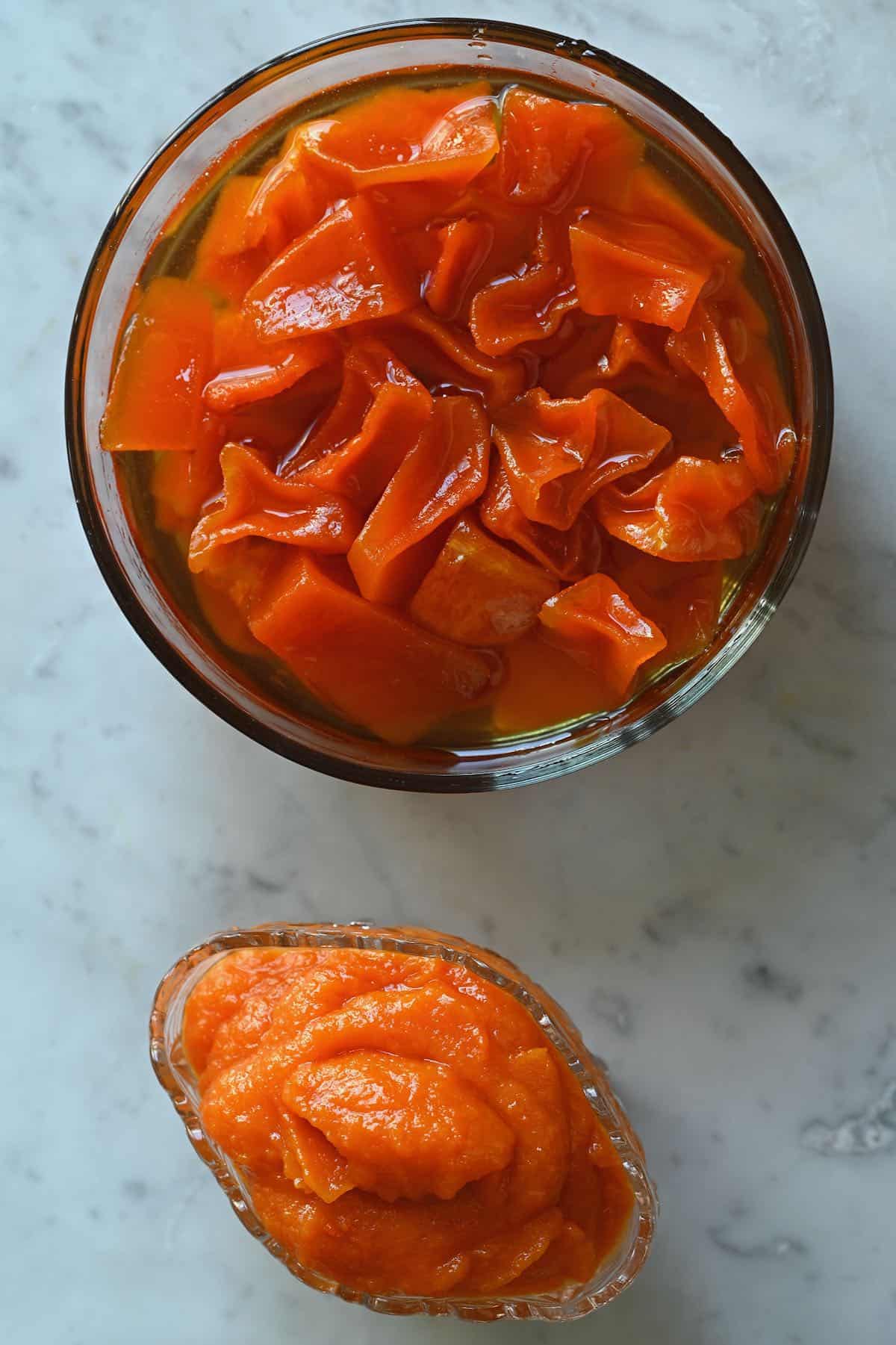
Recipe Notes and Top Tips
- For chewier candied pumpkin pieces (without syrup): you can make candied pumpkin similar to crystallized fruits. To do so, after the long-simmering, transfer the pumpkin pieces to a large wax-paper lined tray and allow them to dry out for 10-12 hours, then optionally roll in sugar.
- Don’t use carving pumpkins: they’re usually fairly lackluster in terms of flavor and texture. Instead, choose a roasting pumpkin (like sugar pumpkin) or even squash – like butternut squash. You can save leftover pumpkins from halloween for something else!
- If you want to preserve the pumpkin: don’t reduce the sugar amount in the recipes, as it acts as a preserver. If you reduce the sugar, the shelf life will be reduced too (and I can’t guarantee how much).
- Experiment with aromatics: I’ve included a list of my favorite add-ins for these pumpkin preserves, so feel free to experiment and find your perfect ingredients and amounts.
- If using pickling crisp: it has quite a “salty” flavor so you may still want to give the pumpkin a quick rinse after the long soak. However, the sugar should neutralize it since it was only used for soaking.
- To make pumpkin slices: you can make larger slices and the process will be exactly the same (since the long cook time will easily cook larger pieces).
Related Recipes and DIYs
- Candied orange slices in syrup
- Crystallized ginger
- Honey fermented ginger and lemon
- How to Make Preserved Lemons (Pickled Lemons)
- Fermented garlic honey
- Garlic and chili-infused honey
- Fig Preserves with no pectin
- Stovetop Lebanese Rice Pudding (Riz bi Haleeb)
- Easy Candied Pecans (Egg-Free | Roasted + Stovetop Methods)
- Canning Peaches (A Step by Step Tutorial)
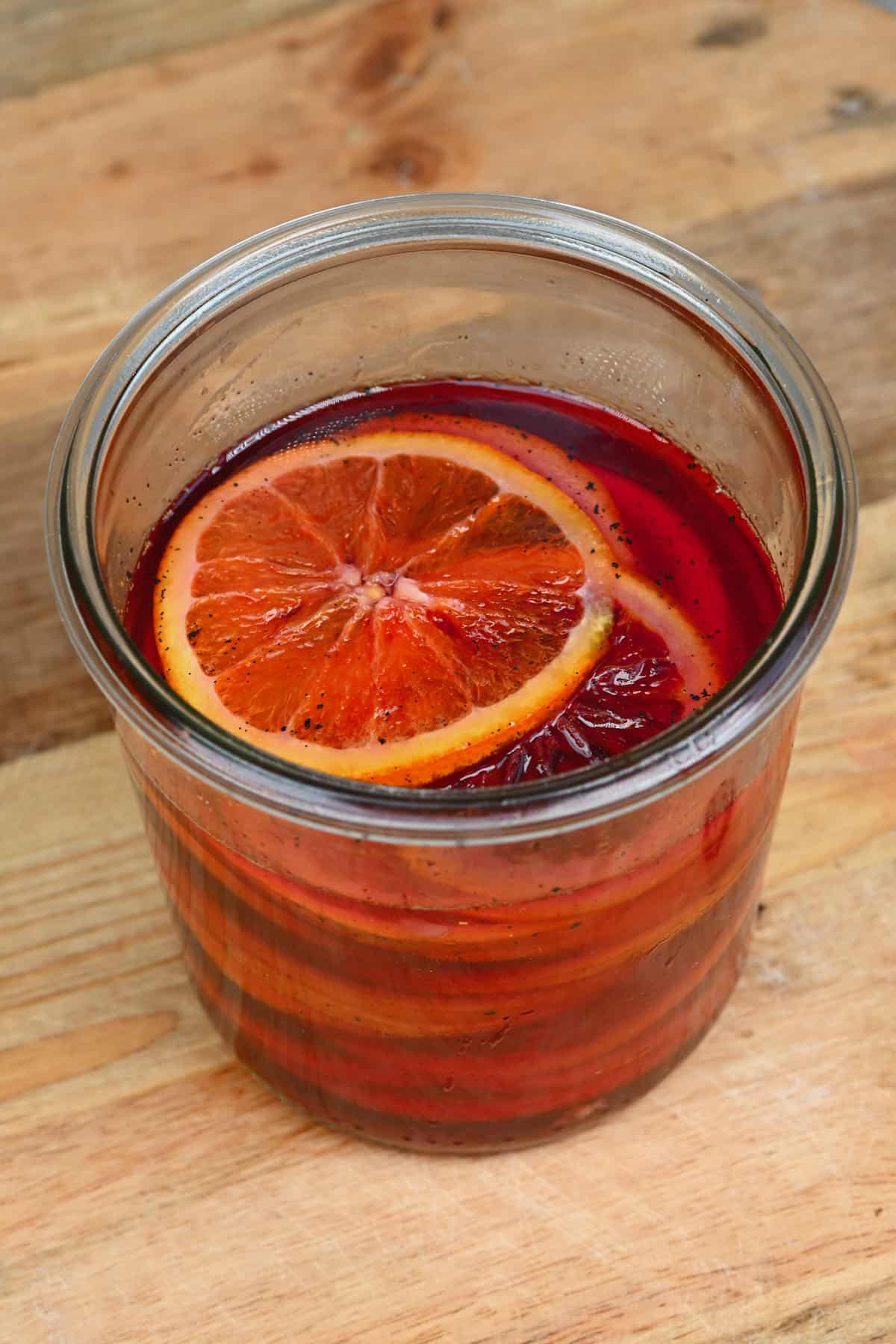
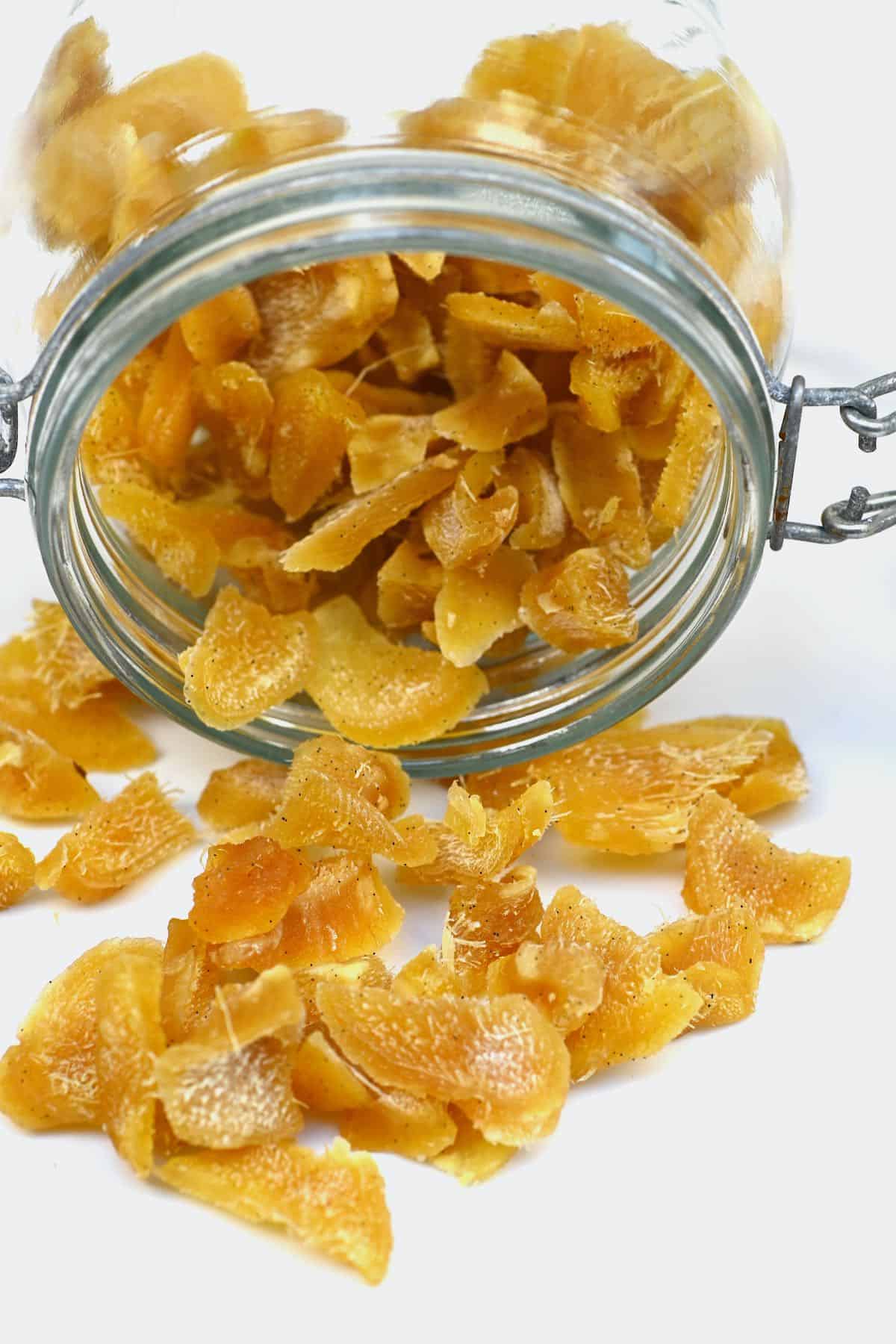
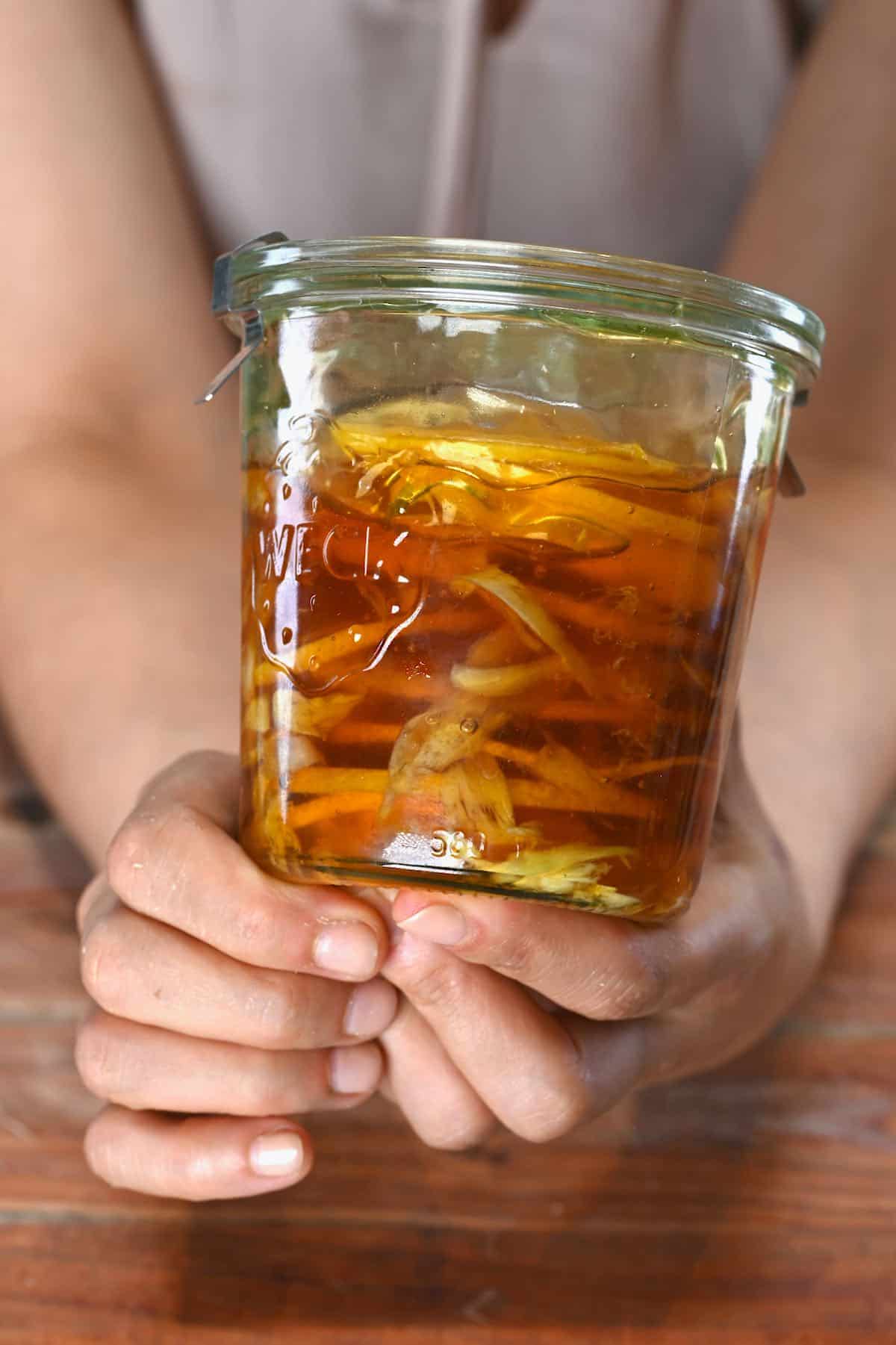
If you try either of these pumpkin preserves recipes, I’d love to hear your thoughts/questions below. Also, I’d appreciate a recipe card rating below, and feel free to tag me in your recipe recreations on Instagram @Alphafoodie!
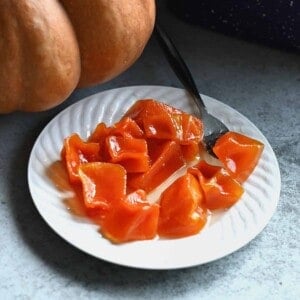
Pumpkin Preserves (Candied Pumpkin + Pumpkin Jam)
Ingredients
- 2.2 lb pumpkin peeled and deseeded; sugar pumpkin, another roasting pumpkin, or butternut squash would work.
- 2.2 lb white sugar
- 8 cups water to cook & candy the pumpkin
- 1/2 cup lemon juice 2-3 lemons; could mix with orange juice
- 1/2 cup pickling lime or corn starch (same amount) OR 1-2 tsp pickle crisp per 8 cups water
Check the Recipe Notes below for optional add-ins and variations!
Instructions
Step 1: Prepare the Pumpkin
- Wash and chop the pumpkin into small bite-sized pieces (around ¾-1-inch cubes). Next, peel or chop the skin away and remove all the pulp and stringy flesh.Then, weigh the pumpkin to be sure of the exact weight (as you’ll need the same amount of sugar to pumpkin weight).
Step 2: Soak and Rinse the Pumpkin
- If you plan to make pureed pumpkin jam, you can skip to Step 3.
- Combine the water (you'll need between 9-12 cups depending on the container you're using) and pickling lime (or starch) in a container large enough to fit all the pumpkin pieces. Allow it to dissolve in the water for 10-15 minutes.
- Add the pumpkin and allow it to soak for about six hours (though up to 12-24 works too to help the pumpkin retain its shape).If you want to use pickle crisp, I recommend using 1 teaspoon per 1/2 gallon of water. Wait until it dissolves, add the pumpkin, and leave it to soak for 2 hours – no rinse necessary.
- After soaking, thoroughly drain the liquid and then rinse the pumpkin THOROUGHLY (if using pickling lime; there's no need when using pickle crisp or starch). I do this multiple times until I'm sure the pieces are completely free of any pickling lime residue. The best way is to first allow them to soak in clean water for an hour. Then continue to rinse and soak the pumpkin in clean water a further two times.
Step 3: Simmer the Pumpkin in Syrup
- Add the pumpkin, sugar, and water in a large, thick-based pan and bring to a boil over medium – medium-high heat. As foam/scum forms at the top of the pan, simply scoop it out with a spoon.
- Once it begins to boil, reduce the heat to a gentle simmer and cook for between 3-4 hours as the mixture thickens and candies the pumpkin pieces. It’s ready when the syrupy sauce coats the back of a spoon.
- Finally, add the lemon juice to the candied pumpkin mixture and remove it from the heat. Allow it to cool before transferring to a sterilized container/s.If you’re making pumpkin jam, you can get away with simmering for an hour and can use an immersion blender or regular blender to form a smooth puree before transferring it to the container.
Quick "Cheat" Pumpkin Jam
- If you want to make a super quick and simple pumpkin jam (similar to pumpkin butter), then you can cut out several steps (and ingredients).For a small batch, I recommend using 15 oz (400 g) of pumpkin puree (that way, you can use homemade or canned pumpkin), an equal amount of sugar (2 cups/400g), 1-2 tablespoons of lemon juice (though orange would also work), and 1-2 tsp pumpkin pie spice (or just a pinch of cinnamon and nutmeg). Feel free to adjust the citrus and spices to personal taste!
- First, add the pumpkin, citrus, and spices to a medium or large saucepan and cook over medium-high, stirring often, for a couple of minutes. Then, add the sugar, and mix it in well. Continue to cook until it begins to boil, then slightly reduce the heat and cook, stirring constantly, until the sugar is fully dissolved and the mixture thickens (10-15 minutes) into a moldable consistency. Finally, taste the pumpkin jam and adjust the spices or citrus to taste. Then remove from the heat, allow to cool slightly, and transfer to a sterile glass jar.If you use fresh pumpkin puree, this is usually "wetter" than canned, so it will take longer to thicken and reduce. Note that this mixture also "spits" quite a lot while cooking, so wear an apron/oven mitt if preferred.You can store this cheat pumpkin pie jam in the fridge for up to three months. You may also be able to water bath can it, though it's best to refer to professional guidelines for more advice.
How to Store Pumpkin Preserves.
- Store: you can store the candied pumpkin and pumpkin jam in sterilized glass jars in the fridge for up to three months.Note that it's possible to water bath can (full method instructions in link) this recipe – processing it for 10 minutes. If you do so, the pumpkin preserves will last for 12 months (at least!).Freeze: I haven't tried to freeze either of these pumpkin preserves, though I imagine the pumpkin jam would freeze well for several months. It may impact the texture of the candied pumpkin, though.
Notes
- For chewier candied pumpkin pieces (without syrup): you can make candied pumpkin similar to crystallized fruits To do so, after the long-simmering, transfer the pumpkin pieces to a large wax-paper lined tray and allow them to dry out for 10-12 hours, then optionally roll in sugar.
- Don’t use carving pumpkins: they’re usually fairly lackluster in terms of flavor and texture. Instead, choose a roasting pumpkin (like sugar pumpkin) or even squash – like butternut squash. You can save leftover pumpkins from Halloween for something else!
- If you want to preserve the pumpkin: don’t reduce the sugar amount in the recipes, as it acts as a preserver. If you reduce the sugar, the shelf life will be reduced too (and I can’t guarantee how much).
- Experiment with aromatics: I’ve included a list of my favorite add-ins for these pumpkin preserves, so feel free to experiment and find your perfect ingredients and amounts.
- If using pickling crisp: It has quite a “salty” flavor so you may still want to give the pumpkin a quick rinse after the long soak. However, the sugar should neutralize it since it was only used for soaking.
- To make pumpkin slices: you can make larger slices and the process will be exactly the same (since the long cook time will easily cook larger pieces).
- Mastic powder: this is optional but is an aromatic powder that can help to add extra flavor to the candied pumpkin/syrup mixture. The taste is hard to describe but is like woodsy, musky vanilla with hints of anise/mint.
- Pumpkin seeds/pistachios: you can add them directly to the jar with the candied pumpkin or just use them to garnish when serving.
- Orange zest: ½ – 1 orange zest can be added to the sugar syrup mixture to infuse it with extra flavor.
- Vanilla: I recommend using around ½ a vanilla bean, scraping out the seeds, and throwing the entire pod in while cooking (then remove the pod at the end).
- Spices: there are several easy ways you can add more flavor to the pumpkin preserves, including adding cinnamon (sticks or powdered), nutmeg, whole cloves (just 2-3 as the taste is strong!), or even pumpkin pie spice
- Ginger: just a little fresh ginger can help to infuse the pumpkin (and syrup) with more flavor. It works well for the jam too.
- Chili: adding a small amount of finely chopped chili can help balance the sweetness and add a pop of heat to the pumpkin preserves. Adjust the amount to taste – but I recommend 1 small red chili to begin.
Nutrition
Nutrition information is automatically calculated, so should only be used as an approximation.

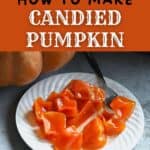
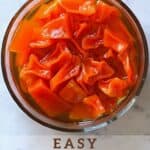
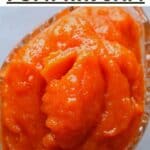
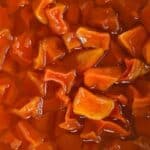
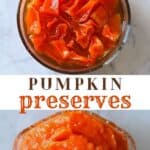

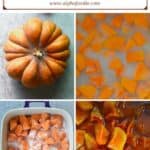









Thanks for sharing. I have several squash that I’ve been looking for things to do with. And you may be able to make lower sugar jam if lemon or lime juice is added at the end. Maybe 2 tablespoons per batch? It would change the flavour a bit but I like a sour note in my jams.
Thank you for the tip, Simone! Sounds great.
Thank you so much.
Thank you for your comment!